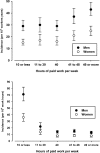Determinants of workplace injury among Thai Cohort Study participants
- PMID: 23869104
- PMCID: PMC3717462
- DOI: 10.1136/bmjopen-2013-003079
Determinants of workplace injury among Thai Cohort Study participants
Abstract
Objectives: To explore individual determinants of workplace injury among Thai workers.
Design: Cross-sectional analysis of a large national cohort.
Setting: Thailand.
Participants: Thai Cohort Study participants who responded to the 2009 follow-up survey were included if they reported doing paid work or being self-employed (n=51 751).
Outcome measures: Self-reported injury incidence over the past 12 months was calculated. Multivariate logistic regression models were used to test associations between individual determinants and self-reported workplace injury.
Results: Workplace injuries were reported by 1317 study participants (2.5%); the incidence was 34 (95% CI 32 to 36)/1000 worker-years for men, and 18 (17-20) for women. Among men working ≥41 h and earning <10 000 Baht, the injury rate was four times higher compared with men working <11 h and earning ≥20 001 Baht; differences in injury rates were less pronounced in women. Multivariate modelling showed that working ≥49 h/week (23%) and working for ≤10 000 Bath/month (37%) were associated with workplace injury. The increase in injury risk with increased working hours did not exceed the risk expected from increased exposure.
Conclusions: Reductions in occupational injury rates could be achieved by limiting working hours to 48/week. Particularly for Thai low wage earners and those with longer workdays, there is a need for effective injury preventive programmes.
Keywords: EPIDEMIOLOGY; OCCUPATIONAL & INDUSTRIAL MEDICINE; PUBLIC HEALTH.
Figures



References
-
- Sleigh AC, Seubsman SA, Bain C. Cohort profile: The Thai Cohort of 87,134 Open University students. Int J Epidemiol 2008;37:266–72 - PubMed
-
- Siriruttanapruk S, Anantagulnathi P. Occupational health and safety situation and research priority in Thailand. Ind Health 2004;42: 135–40 - PubMed
-
- Siriruttanapruk Sat Integrating occupational health services into public health systems: a model developed with Thailand's primary care units. Bankok: Office IL, 2006
-
- Vegso S, Cantley L, Slade M, et al. Extended work hours and risk of acute occupational injury: a case-crossover study of workers in manufacturing. Am J Ind Med 2007;50:597–603 - PubMed
-
- Lombardi DA, Folkard S, Willetts JL, et al. Daily sleep, weekly working hours, and risk of work-related injury: US National Health Interview Survey (2004–2008). Chronobiol Int 2010;27:1013–30 - PubMed
LinkOut - more resources
Full Text Sources
Other Literature Sources
Miscellaneous
